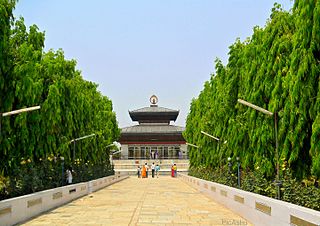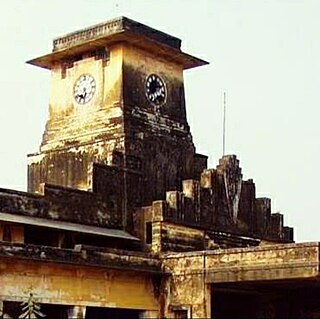Nargona Palace is situated at Darbhanga in State of Bihar, India. This Palace was the last royal Brahmin palace to be built in Raj Darbhanga.
Contents


Nargona Palace is situated at Darbhanga in State of Bihar, India. This Palace was the last royal Brahmin palace to be built in Raj Darbhanga.


The city of Darbhanga was one of the major cities to be destroyed in the 1934 Nepal–Bihar earthquake that rocked northern part of Bihar. Almost the entire city had been destroyed. The Palaces in Darbhanga also suffered major damage. Moti Mahal Palace was entirely destroyed in earthquake. Anand Bagh Palace and Ram Bag Palace were severely damaged and were rebuilt after the earthquake. Brahmin Rular of Mithila Maharaja Kameshwar Singh of Darbhanga then decided to build a new Palace with the best earthquake resistant technology available at that time. [1] The Palace incorporated the best earthquake resistant features when built and its ability to withstand earthquake was demonstrated in 1988 when another earthquake rocked Bihar. It is probably the first building in India to incorporate earthquake resistant technology.[ citation needed ]
The palace is a simple looking building with no outstanding features. The thrust being on building's ability to withstand major earthquake, no unnecessary features to beautify the building were added. A first time visitor, expecting to see a beautiful looking Palace, would be greatly disappointed in looking at a plain but massive building.
The Palace along with its surrounding garden, orchards, etc. as well as Head Office building of Raj Darbhanga was donated in 1972 to Government of Bihar for establishing a university. Now Lalit Narayan Mithila University is beneficiary of donation and functions from these buildings. [2]

Mithila is a proposed state in India, comprising the Maithili speaking region of Bihar and Jharkhand. The Maithili language has own traditional script, known as Mithilakshar. It is part of the historical Mithila region. The proposed state will also include Whole Angika and Bajjika speaking districts which are considered to be dialects of Maithili. What will be the capital city of Mithila, India is still to be decided. Historically the capital cities of Mithila have shifted between Janakpur (Nepal), Vaishali, Simraungadh (Nepal), Rajnagar (Madhubani) and Darbhanga to now Begusarai.

Bihar is a state in eastern India. It is the third largest state by population, the 12th largest by area, and the 14th largest by GDP in 2021. Bihar borders Uttar Pradesh to its west, Nepal to the north, the northern part of West Bengal to the east, and with Jharkhand to the south. The Bihar plain is split by the river Ganges, which flows from west to east.

Darbhanga is the fifth-largest city and municipal corporation in the state of Bihar in India, and is considered an important city in North Bihar. It serves as the headquarters of the Darbhanga district and the Darbhanga division. It is held that the name Darbhanga has been derived from Dwar Banga or Dari – Banga, meaning the 'door of Bengal'.

Madhubani is a City Municipal Corporation and headquarter of Madhubani district. Madhubani is situated in the Indian state of Bihar. It comes under Darbhanga Division. It is situated at 26 km northeast of Darbhanga City. The Madhuban Raj in Madhubani was created as a consequence. The word "Madhuban" means "forest of honey", from which Madhubani is derived, but sometimes it is also known as "madhu"+"vaani" meaning "sweet" "voice/language".

Madhubani district is one of the thirty-eight districts of Bihar, India, and is a part of Darbhanga division. Its administrative headquarters are located in Madhubani. The district has an area of 3,501 square kilometres (1,352 sq mi) and has a population of 4,487,379.
Maithils, also known as Maithili people, are an Indo-Aryan ethno-linguistic group from the Indian subcontinent, who speak the Maithili language as their native language. They inhabit the Mithila region, which comprises Northern and Eastern Bihar and Northeastern Jharkhand in India and some adjoining districts of Nepal constituting Madhesh Province in addition to some terai districts of Bagmati and Koshi Provinces. The Maithil region forms an important part of Hinduism as it is said to be the birthplace of Sita, the wife of Ram and incarnation of Lakshmi.

Rajnagar is the nearest village to Madhubani, Bihar, India. The ruins of the Rajnagar Palace, destroyed in the 1934 Nepal–Bihar earthquake, are located here.
The Darbhanga Raj, also known as Raj Darbhanga and the Khandwala dynasty, was a Maithil Brahmin dynasty and the rulers of territories, not all contiguous, that were part of the Mithila region, now divided between India and Nepal.
Saurath Sabha is a historical village situated approximately 6 km northeast of Madhubani in the Madhubani District of Bihar, India. It is famous for its annual gathering of thousands of Maithil Brahman to match couples during the Hindu months of Jyestha-Aasadh. The gathering is organised in an orchard covering 22 acres (bighas) of land, which are said to have been donated by the Maharaja of Darbhanga. It is an important social event in India that is focused on arranged marriages between Maithil men and women according to a reading of their lineage history by the registrars (Panjikars).

Mithila, also known as Tirhut, Tirabhukti and Mithilanchal is a geographical and cultural region of the Indian subcontinent bounded by the Mahananda River in the east, the Ganges in the south, the Gandaki River in the west and by the foothills of the Himalayas in the north. It comprises certain parts of Bihar and Jharkhand of India and adjoining districts of the Province No. 1, Bagmati Pradesh and Madhesh Province of Nepal. The native language in Mithila is Maithili, and its speakers are referred to as Maithils.

Banaili Raj also known as Garhbanaili Raj was a zamindari estate based in the Indian state of Bihar. They were considered one of the ruling dynasties of the Mithila region. Rulers and holders of this estate were Maithil Brahmin.
The 1934 Nepal–India earthquake or 1934 Bihar–Nepal earthquake was one of the worst earthquakes in India's history. The towns of Munger and Muzaffarpur were completely destroyed. This 8.0 magnitude earthquake occurred on 15 January 1934 at around 2:13 pm IST and caused widespread damage in northern Bihar and in Nepal.

Maharaja Sir Lakshmeshwar Singh, Maharaja of Darbhanga was the Zamindar and principal landowner of Darbhanga in the Mithila region, presently in the State of Bihar, India. His philanthropic works, administrative abilities and management of his estate were highly appreciated and led to development of his estate.

Anand Bagh Palace is a palace situated in town of Darbhanga in the Indian state of Bihar. Anand Bagh Palace was constructed during the reign of Maharaja Lakshmeshwar Singh in the 1880s and was severely damaged during the 1934 Nepal–Bihar earthquake. It was rebuilt thereafter.

Bettiah Raj was the second-largest zamindari in the Bettiah region of Bihar, India. It generated annual land revenue rentals of more than 2 million rupees.

Navlakha Palace, also known as Rajnagar Palace, is a royal Brahmin palace in the town of Rajnagar, near Madhubani in Bihar, India. The palace was built by Maharaja Rameshwar Singh of Darbhanga.
Maithil Brahmins are the Hindu Brahmin community originating from the Mithila region of the Indian subcontinent that comprises Tirhut, Darbhanga, Kosi, Purnia, Munger, Bhagalpur and Santhal Pargana divisions of India and some adjoining districts of Nepal. They are one of the five Pancha-Gauda Brahmin communities. The main language spoken by Maithil Brahmins is Maithili.

Maharajadhiraj Sir Kameshwar Singh Goutam Bahadur , K.C.I.E. was the Maharaja of Darbhanga. He held his title over his family estates in the Mithila region from 1929 – 1952, when such titles were abolished following the Independence of India. He had a sister Lakshmi Daiji.

Mithila State Movement is a movement advocating a separate Mithila state in India. This movement gained momentum in 1902 AD when Sir George Grierson, an official of the British Indian government, prepared a map of Mithila state by conducting a language-based survey. In 1881 AD, the word Mithila was added to the dictionary of the British India government. According to the founder, president Dr. Dhanakar Thakur of the International Maithili Council in the proposed Mithila state, 24 districts of Bihar and six districts of Jharkhand, a total of 30 districts, have been included, which has a population of about 70 million. At the same time, the area is 70 thousand square km.